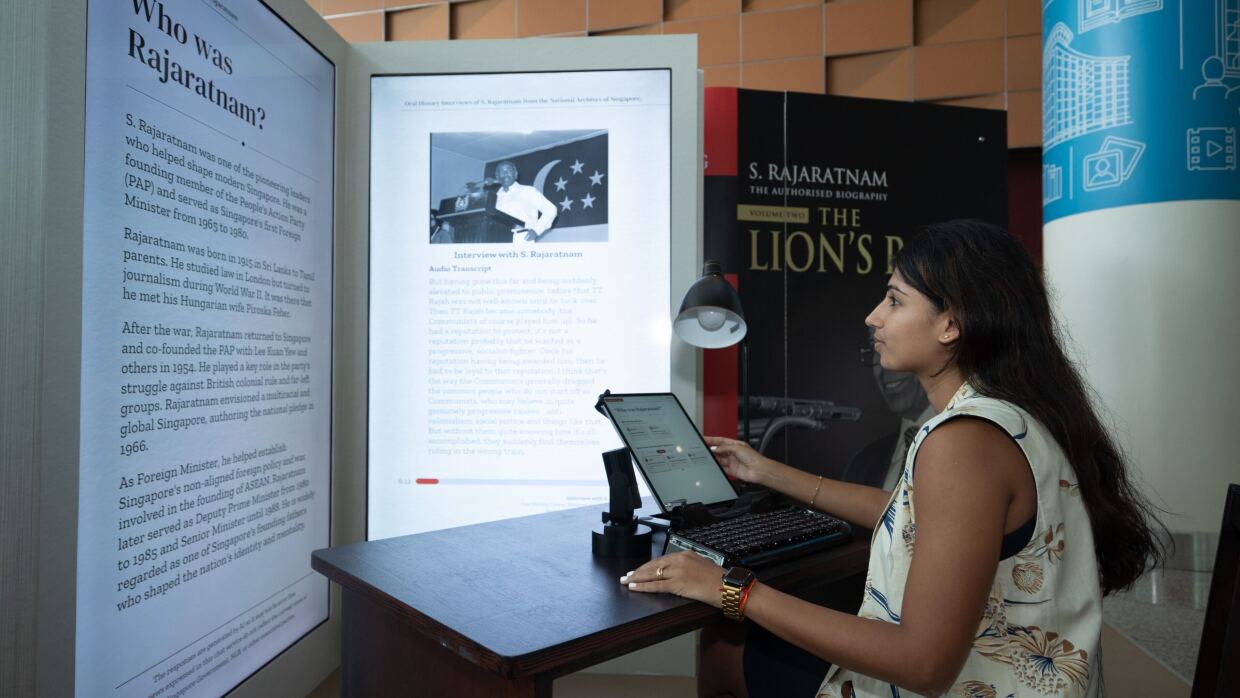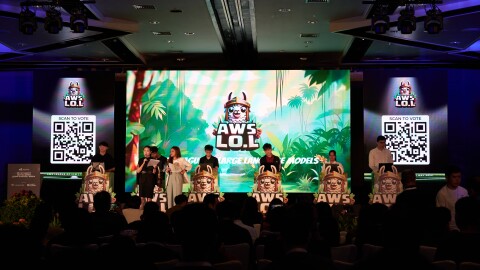(Above image credit: National Library Board)
In 1974, nearly a decade before the internet’s inception, Singapore’s first Minister for Foreign Affairs Sinnathamby Rajaratnam (known as S. Rajaratnam), foresaw an era of immediate connectivity and video calls. Speaking at the opening ceremony of a telecommunications antenna on Sentosa island, he envisioned that advancements in communications could lead to teleconferencing, bringing the world more closely together and giving people “instant access to knowledge anywhere”. Decades later, technology has brought his predictions to life at the National Library Building.
Here, the National Library Board’s (NLB) new experience powered by generative AI is enabling visitors to seamlessly interact with a wealth of information on S. Rajaratnam’s life, spanning his ideology to his musical preferences.
S. Rajaratnam, who passed away in 2006 at the age of 90, was one of Singapore’s visionary founding fathers. Known for his rich intellect and groundbreaking ideas, he championed the transformation of Singapore into a ‘Global City’, foreseeing the opportunities that technological progress would bring as cities entered the global stage.

History comes alive through technology
NLB’s latest tech prototype, the ChatBook Featuring S. Rajaratnam, developed by Amazon Web Services (AWS) is the first publicly available ChatBook, and is open to all until 21 October 2024 at the National Library Building. It was officially opened on 22 July 2024 by Singapore’s Prime Minister Lawrence Wong, alongside the launch of The Lion’s Roar: The Authorised Biography of S Rajaratnam, Volume Two by biographer Irene Ng, who published the first volume in 2010.
Ng, who has dedicated years to retracing the statesman’s journey through interviews with S. Rajaratnam’s contemporaries and extensive archival research, said: “Rajaratnam, who was Singapore’s first Culture Minister and its first Foreign Minister, holds a special place in the country’s history. Throughout his life, his personal compulsion was to shape the future, and his passion was to communicate with people, educate them, and stir their imagination. It is fitting that this first-of-its-kind ChatBook focuses on this founding leader. I hope that, through this interactive ChatBook, people from walks of life can pick up valuable insights not only on his life and legacy, but also learn what individuals can achieve, if they have the wisdom, the guts and the will to struggle for it.”

How it works
The ChatBook Featuring S. Rajaratnam currently takes centrestage within the showcase area. Here, there are two large ChatBooks designed to resemble open copies of Ng’s biography on S. Rajaratnam. Each ChatBook stands in a cosy space designed to replicate a study to reflect S. Rajaratnam’s love of reading and writing, with a desk, chair, typewriter-like setup comprising a keyboard and tablet, and microphone.
Visitors can converse with the ChatBook by entering a question on the keyboard, speaking into the microphone, or tapping on the suggested questions displayed on the tablet. The query is promptly reflected on the ChatBook’s left-hand page. Within moments, the ChatBook generates a concise response drawn from material from NLB and the National Archives of Singapore’s (NAS) collections as well as authoritative sources, such as Ng’s biography. On the right-hand page, users can explore primary sources of the summarised response as well as other materials about S. Rajaratnam. Visitors can pose follow-up questions, dive deeper into the source material, browse related images, or even listen to accompanying audio clips of his oral history interview.
The responses for the ChatBook Featuring S. Rajaratnam prototype were trained on Ng’s comprehensive chronicles of his life, as well as his oral history interview and speeches from NAS, a process that spanned about three months. The materials used for the prototype were those that NLB owned the copyright to and/or had the permissions from Ng and the publishers to use. The experience itself was built on Amazon Bedrock, an AWS-managed service that provides developers with foundational models—algorithms which generate content based on human instructions—enabling the integration of artificial intelligence capabilities into different applications with ease.
At the unique, multi-modal ChatBook showcase, visitors can also discover more about S. Rajaratnam’s contributions through the replicas of archival materials at the bookshelves. There are book displays offering bite-sized information, along with online resources and eBooks that can be borrowed via the NLB Mobile app or downloaded from the NLB website. There is also a selection of physical books, including the biography by Ng, on S. Rajaratnam for browsing.
Of the experience, NLB’s chief executive officer Ng Cher Pong said: “The Generative AI-powered ChatBook Featuring S. Rajaratnam is part of NLB’s ongoing efforts to explore innovative ways of tapping on technologies to engage our patrons. We want to also connect them to the rich content from our collections, in line with our LAB25 (Libraries and Archives Blueprint 2025) Singapore Storytellers role. We will continue to collaborate with partners and the communities to reshape the future of learning and discovery.”
Here’s what the ChatBook had to say.
- Q: What were some of Rajaratnam’s most significant ideas that made Singapore what it is today?A: “One of Rajaratnam’s most significant contributions was his vision of a ‘Singaporean Singapore’. He challenged the fixation on racial categories, arguing for a national identity that transcended race, language and religion.
“Another crucial concept Rajaratnam introduced was that of Singapore as a ‘global city’. This forward-thinking vision, articulated in 1972, was instrumental in positioning Singapore to become a key player in the global network of trade, finance, and services. His emphasis on attracting multinational corporations was radical for its time but proved crucial for Singapore’s economic development.” - Q: What were Rajaratnam’s thoughts on the role of technology in the future of Singapore?A: “Rajaratnam was remarkably prescient about the role of technology in Singapore’s future. He anticipated that, with satellite communication, ‘within seconds, a Singaporean could be in touch with anyone in cities in other parts of the world’.
“He believed technology would be crucial for Singapore’s survival and prosperity. He saw it as a way for Singapore to overcome constraints that pessimists said would sink the country—the small size of its population and its land, and the absence of natural resources.” - Q: What are some of Rajaratnam’s most inspirational quotes?A: “Rajaratnam was known for his inspirational and thought-provoking quotes that continue to resonate with Singaporeans today. One of his most powerful statements encapsulates his philosophy: ‘You can make the tomorrow you want, provided you have the wisdom, the guts and the will to struggle for it.’”
- Q: What was Rajaratnam’s favorite song?A: “Ah, you’re curious about Rajaratnam’s musical tastes! Well, I have a delightful titbit to share with you. Rajaratnam had a particular fondness for the classic love song, When I Fall In Love. This romantic ballad, famously performed by Nat King Cole and later covered by many others, held a special place in his heart. It had a deeper, more personal meaning for Rajaratnam. The song reminded him of his feelings for his wife, Piroska. This connection adds a touching dimension to the political figure we often remember him as.”











